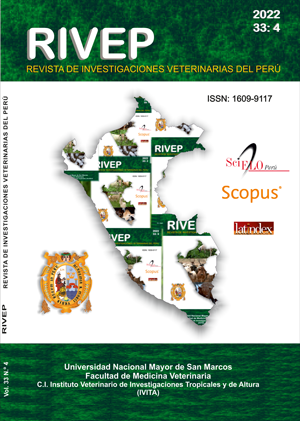Influencia de la oleorresina de Capsicum chinense en la vida útil de la carne de res empacada al vacío y almacenada en refrigeración
DOI:
https://doi.org/10.15381/rivep.v33i4.23347Palabras clave:
ají panca, Capsicum chinense, oleorresina, carne empacada al vacío, vida útil, Brochothrix thermosphactaResumen
El objetivo del estudio fue evaluar el efecto de la aplicación de oleorresina de Capsicum chinense sobre el crecimiento bacteriano en carne de res empacada al vacío y refrigerada. La oleorresina se extrajo con etanol y la capsaicina y dihidrocapsaicina se cuantificaron mediante HPLC con detector de arreglo de diodos. Se constituyeron dos grupos (G1 y G2) que consistían en cortes de carne (50 g): G1 con aplicación de 2.5 ml de la oleorresina en toda la superficie de cada corte, y G2 grupo control. Los cortes de carne fueron empacados al vacío y se almacenaron en refrigeración. Se retiraron tres muestras de cada grupo los días 0, 1, 15, 30, 45, 60, 75 y 90 de almacenamiento para medición de pH y para el recuento de aerobios mesófilos totales, aerobios psicrótrofos totales, bacterias ácido-lácticas y Brochothrix thermosphacta. El rendimiento de oleorresina fue 12.53 ± 0.30%. La concentración de capsaicina y dihidrocapsaicina en la oleorresina fue de 1.39 y 0.54 mg/g, respectivamente. El pH en G1 se mantuvo en niveles adecuados por más días y los recuentos bacterianos fueron menores que en G2-control. Bajo las condiciones de estudio, se determinó que la vida útil para G1 fue de 70 días, mientras que para G2 fue de 56 días. Se concluye que la oleorresina de Capsicum chinense aplicada a carne de res empacada al vacío y refrigerada prolonga su vida útil.
Descargas
Descargas
Publicado
Número
Sección
Licencia
Derechos de autor 2022 Eduardo Alexander Salazar Sánchez, Daphne Ramos Delgado, Juan Raúl Lucas López, Andrea Carhuallanqui, José Alfredo Guevara Franco, María Elena Salazar-Salvatierra

Esta obra está bajo una licencia internacional Creative Commons Atribución 4.0.
LOS AUTORES RETIENEN SUS DERECHOS:
a. Los autores retienen sus derechos de marca y patente, y tambien sobre cualquier proceso o procedimiento descrito en el artículo.
b. Los autores retienen el derecho de compartir, copiar, distribuir, ejecutar y comunicar públicamente el articulo publicado en la Revista de Investigaciones Veterinarias del Perú (RIVEP)(por ejemplo, colocarlo en un repositorio institucional o publicarlo en un libro), con un reconocimiento de su publicación inicial en la Revista de Investigaciones Veterinarias del Perú (RIVEP).
c. Los autores retienen el derecho a hacer una posterior publicación de su trabajo, de utilizar el artículo o cualquier parte de aquel (por ejemplo: una compilación de sus trabajos, notas para conferencias, tesis, o para un libro), siempre que indiquen la fuente de publicación (autores del trabajo, revista, volumen, numero y fecha).



